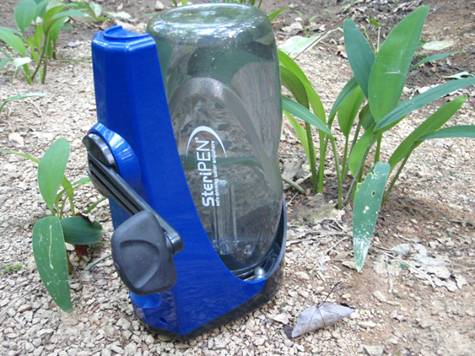
A hand-crank UV device (Photo by Tim MacWelch)
What if you could make safe drinking water with nothing more than light? It may sound like science fiction, but it really is a fact. One of the most recent innovations in water disinfection is the portable UV light purifier. This device doles out a lethal dose of ultraviolet light, which kills or wounds many different types of waterborne pathogens. There are two main types of UV purifiers to choose from.
UV Pens
These little pocket-sized UV purifiers typically run on two AA batteries and work with push-button ease. To use, stick the light element into a glass of water. Hit the button and a 45-second cycle of glowing blue light will begin. The lightbulb should be stirred through the water. In most cases, the water should be safe for immediate drinking. If the water was slightly cloudy, zap it a second time.
UV Hand-Crank Models
What if you are out of batteries? There are hand-crank UV purifiers that provide disinfection with just a minute of manual labor. Fill the water bottle (in the kit) from your local source. Screw the bottle onto the device’s housing and flip it. Crank the handle until the LED light turns green (about 90 seconds). Flip it again, unscrew the bottle, wipe the threads clean, and repeat.
And whichever device you use, understand that cloudiness or significant solids in water will create hiding places for bacteria to elude the burning light of a UV device. This can mean that multiple doses of UV light still cannot properly disinfect the water, so make sure you use clear water with UV methods.
What About SOLDIS?
Technological devices aren’t the only source of UV light. SOLDIS (also referred to as SODIS) is a water treatment method that uses the sun’s UV rays for disinfection. Largely advocated for developing countries, solar water disinfection is gaining some traction in the survival skills crowd. The most common technique is to expose plastic bottles full of contaminated water to the sun for a minimum of one day. The sun’s abundant UV light kills or damages almost all biological hazards in the water. The advantages to this way of treating water are plentiful. It’s easy to use; it’s inexpensive or free; it offers good (but not complete or guaranteed) bacterial and viral disinfection. Furthermore, the method uses no dangerous chemicals; and it does not require constant attention to use.
Now for the bad news: You need sunny weather, or two days of overcast sky, to reach the maximum effectiveness. You cannot use it in rain; it offers no residual disinfection; it may be less effective against bacterial spores and cyst stages of some parasites (similar to chlorine); the water and the bottle need to be clear. If that wasn’t bad enough, this method does nothing to help with chemical contamination, and only small bottles can be processed (the bottles must be 2 liter or smaller).
For more info and additional resources, you can check out the CDC page on SOLDIS here.
Start now to make sure you are staying prepared.
Via: outdoorlife




 Follow
Follow
Leave a Reply